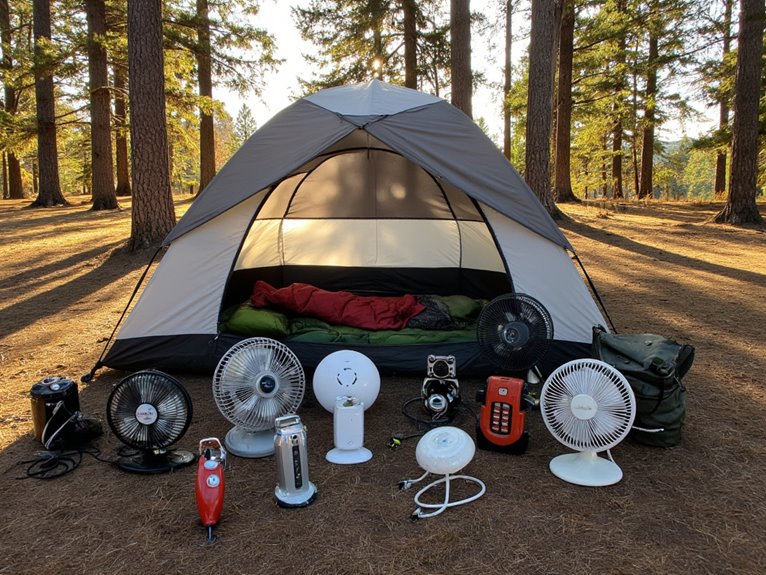How Can I Add Warmth to My Sleeping Bag?
To add warmth to your sleeping bag, consider using sleeping bag liners, which can increase the bag's temperature rating by 5-10°F. Sleeping bag pads can also provide an extra layer of insulation, reducing heat loss. Thermal reflective materials, such as aluminum or silver-coated fabrics, can retain body heat, while wearing warm clothing like thermal socks and base layers can trap warmth. DIY modifications, like adding a layer of reflective insulation or extra fiberfill, can also boost insulation. By implementing these solutions, you can substantially improve your sleeping bag's warmth and comfort. Delve into these options in more depth to discover the perfect combination for your needs.
We are supported by our audience. When you purchase through links on our site, we may earn an affiliate commission, at no extra cost for you. Learn more. Last update on 18th December 2025 / Images from Amazon Product Advertising API.
Insulate With Sleeping Bag Liners
Insulate With Sleeping Bag Liners
Sleeping bag liners provide an additional layer of insulation, trapping warm air and increasing the overall temperature rating of your sleeping bag.
This simple yet effective accessory can add 5-10°F of warmth to your sleeping bag, making it ideal for cold-weather camping.
Liners are typically made of lightweight, breathable materials like silk, cotton, or synthetic fabrics, allowing for moisture-wicking properties that prevent condensation buildup.
They are also easy to care for and can be machine washed and dried.
Add Warmth With Sleeping Bag Pads
For campers seeking additional warmth and comfort, sleeping bag pads offer a practical solution, providing an extra layer of insulation between the sleeping bag and the ground.
These pads are designed to reduce heat loss, keeping you warmer and more comfortable throughout the night.
Look for pads with high R-value ratings, which measure thermal resistance, to guarantee maximum insulation.
Additionally, consider pads with foam or air-filled designs, which can be adjusted to suit your preferred level of firmness.
Boost Insulation With Reflective Materials
When considering boosting insulation in a sleeping bag, reflective materials can play a vital role.
By incorporating thermal reflective linings, selecting prime insulating materials, and harnessing the radiant barrier effect, outdoor enthusiasts can markedly improve the warmth and efficiency of their sleeping bag.
These strategies can be particularly effective in cold weather conditions, making them essential considerations for anyone looking to stay warm and comfortable in the great outdoors.
Thermal Reflective Linings
Thermal reflective linings, which involve the strategic integration of reflective materials into sleeping bag design, have emerged as a promising solution for boosting insulation and retaining body heat in cold conditions.
By incorporating reflective materials, such as aluminum or silver-coated fabrics, sleeping bags can better retain radiant body heat, reducing heat loss and keeping you warmer.
This innovative technology is particularly effective in extreme cold weather conditions, where every degree of warmth counts.
Insulating Material Selection
Effective insulation relies on the strategic selection of materials that can efficiently trap and retain body heat, with reflective materials being a crucial component in this process.
When choosing insulating materials, consider those with high loft, compressibility, and moisture-wicking properties.
Synthetic insulation, such as polyester or nylon, provides excellent warmth-to-weight ratios and performs well in damp conditions.
Down insulation, on the other hand, excels in dry, cold environments.
Reflective materials like aluminized Mylar or metallized polyester can substantially boost insulation performance by reflecting radiant heat back to the body.
Radiant Barrier Effect
In addition to selecting the right insulating materials, incorporating reflective materials that exploit the radiant barrier effect can substantially improve the overall insulating performance of a sleeping bag.
This phenomenon occurs when a reflective material, such as aluminized Mylar or space blankets, is placed near a heat source (in this case, the sleeper's body). The reflective material reflects radiant heat back to the source, rather than allowing it to escape, thereby reducing heat loss.
Use reflective materials with a high albedo (reflectivity) to maximize the radiant barrier effect.
Place the reflective material close to the sleeping bag's insulation to enhance its effectiveness.
Consider using reflective materials with a breathable, moisture-wicking design to prevent condensation buildup.
Radiant barrier effects can be especially beneficial in extremely cold conditions or for users who tend to feel cold while sleeping.
Combine reflective materials with other insulation strategies for maximum warmth and comfort.
Use Hot Water Bottles for Warmth
By incorporating hot water bottles into your sleeping bag setup, you can harness the soothing warmth they provide to stay cozy on even the chilliest of nights.
Fill the bottle with warm water, not boiling, to avoid discomfort or burns.
Place the bottle near your feet or torso, where the blood flow is closest to the surface, to maximize the warmth.
You can also wrap the bottle in a cloth or towel to protect your skin from direct contact.
This simple yet effective technique is especially useful for camping in cold weather or for individuals who feel cold while sleeping.
Hot water bottles provide a gentle, consistent heat that can make a significant difference in your sleeping comfort.
Increase Warmth With Thermal Socks
In terms of increasing warmth while sleeping, thermal socks can be a game-changer.
The key to their effectiveness lies in the materials used, which can substantially impact their ability to retain body heat.
Thermal Sock Materials
Thermal sock materials, specifically those with high-loft fleece, synthetic insulation, or moisture-wicking properties, can substantially boost the warmth of my sleeping bag.
The right thermal sock material can make a significant difference in keeping my feet warm and toasty.
High-loft fleece provides excellent insulation and warmth.
Synthetic insulation such as Polarguard or Thinsulate retains warmth even when wet.
Moisture-wicking materials like Merino wool or polyester help regulate body temperature.
Thermal sock materials with a high tog rating (e.g., 2.5-3.5) provide maximum warmth.
Look for socks with a breathable, moisture-wicking outer layer to prevent overheating.
Sleeping Temperature Boost
Wearing thermal socks with high-loft fleece, synthetic insulation, or moisture-wicking properties can increase the sleeping temperature rating of my sleeping bag by as much as 5-10°F (3-6°C), making a significant difference in my overall sleeping comfort.
This is because thermal socks provide an additional layer of insulation, trapping warm air close to my skin and reducing heat loss.
By combining thermal socks with a sleeping bag, I can enjoy a warmer and more comfortable sleeping experience.
Additionally, thermal socks can be worn in conjunction with other warmth-boosting strategies, such as wearing a hat and using a hot water bottle, to create an even cozier sleeping environment.
Furthermore, by incorporating thermal socks into my sleep system, I can stay warm and comfortable even in cold temperatures.
Wear Warm Clothing to Bed
Most outdoor enthusiasts agree that donning warm clothing to bed is an effective way to stay cozy in cold weather. This simple yet effective trick can make a significant difference in your sleeping bag's warmth.
By wearing warm clothing, such as thermal base layers, fleece jackets, or wool socks, you can trap body heat and stay warm throughout the night.
Some essential items to wear to bed include:
- Thermal base layers (top and bottom)
- Fleece jacket or pullover
- Warm socks (wool or synthetic)
- Insulating hat or beanie
- Gloves or hand warmers for extreme cold
Enhance Insulation With DIY Mods
For those seeking an extra layer of warmth without breaking the bank, a few creative DIY modifications can significantly boost the insulation of your sleeping bag.
One simple modification is to add a layer of reflective insulation, such as space blankets or emergency blankets, to the interior of your sleeping bag. This will help to reflect body heat back to the sleeper, increasing warmth.
Another option is to add extra insulation, such as polyester fiberfill or down, to the bag's compartments.
Additionally, you can use a hot water bottle wrapped in a towel to keep your feet warm.
These DIY mods can make a significant difference in the warmth of your sleeping bag without requiring a complete replacement.




